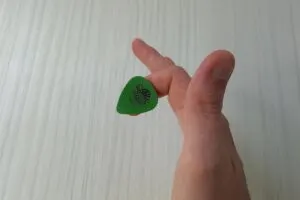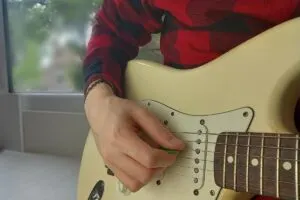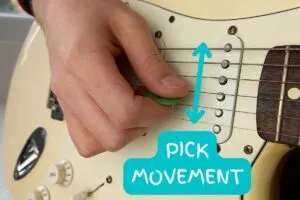For modern guitar players, the guitar pick is an essential tool for playing the instrument. Knowing how to use a guitar pick is an important skill for beginner guitarists to learn, as using the wrong technique can really affect your playing later on. And, unlearning bad guitar picking habits is hard to do!
It’s worth noting that not all guitarists follow the status quo. Dire Straits’ front man Mark Knopfler doesn’t even use a pick! But, despite creative preferences, there is a standard way to use a guitar pick that that all guitarists should learn.
I’ve put this guide together to teach you the fundamentals of how to use a guitar pick (including photo instructions further down) so that you can develop a great picking technique that will serve you well for years to come.
Affiliate disclaimer: This page contains affiliate links for products that I’ve tried and tested. As an Amazon Associate I earn from qualifying purchases at no additional cost to you. Learn more here.
What is a guitar pick?
Guitar picks, also known as plectrums, are small, triangular shaped pieces of material that are used for playing guitar strings. They’re most commonly made of plastic, but can be made of rubber, wood, and even metal or stone.
Traditionally, classical guitar players use their fingernails to individually pick each string. This produces a brighter sound than using the tips of the fingers, which can sound dull. However, playing using your fingernails isn’t really an option for electric guitar. Modern guitarists need a durable tool that can stand up to the thicker strings and more aggressive playing styles of today.
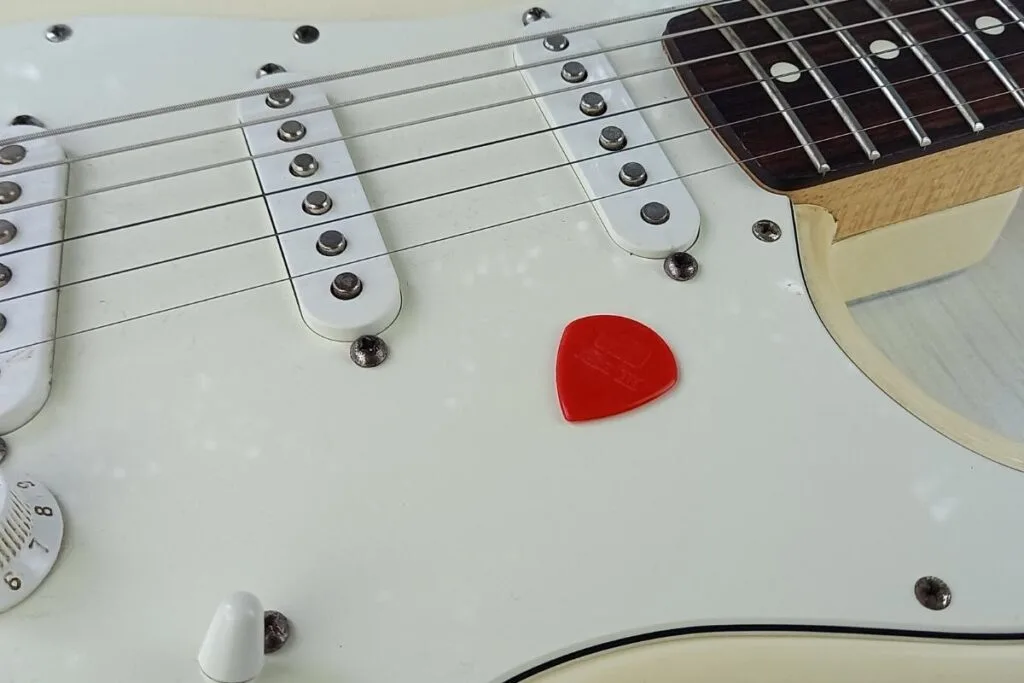
Thus, the guitar pick is the standard tool used by guitarists today. It still produces the bright, clear sound that a traditional fingerstyle playing does, but makes playing much easier.
Picks are an essential tool for any beginner guitarist.
Read more: Best Guitar Picks for Beginners (2022)
What are guitar picks used for?
Guitar picks are used for strumming and picking guitar strings so that they make a noise.
Some techniques are possible once you’ve mastered how to hold a guitar pick, such as alternate picking (meaning alternating upward and downward strokes). More advanced picking techniques include economy picking, sweep picking, and hybrid finger-picking styles.
Guitar picks are used by pretty much every modern guitarist. They’re essential for playing clean, clear notes and increasing your playing speed. In order to do this, you’ll need to learn how to hold and use the guitar pick.
Does it matter how you hold a guitar pick?
Learning how to properly use a guitar pick is essential for beginner guitarists. If you don’t have a proper technique, then it’s going to make playing a lot harder. Not only this, but by practicing the wrong technique, you’ll be developing a bad habit. Once the habit is formed, it’s going to be hard to relearn the proper technique.
So, it’s important to learn how to use a guitar pick properly.
That being said, there are some guitarists that are known for using their guitar picks in unusual ways. James Hetfield (Metallica) uses three fingers to hold his pick. Legendary shred guitarist Yngwie Malmsteem uses the outside of his palm as an “anchor” on the guitar.
Now, these picking techniques aren’t “wrong”, because they clearly work for these guitarists. But, they’re the exceptions to the rule.
You’ll have a lot more success with playing guitar by holding and using your guitar pick in a “normal” way. Once you’ve developed a good technique, then you can start experimenting with different ways of using the pick. As the saying goes: you have to learn how to walk before you run!
How to use a guitar pick
Holding and using a guitar pick is an essential skill for guitarists to learn. By developing a good technique early, you’re setting yourself up for success in the future!
Now, there’s no “one way” to hold a guitar pick. But, this is the way that I learned how to do it, and that many other guitarists use. You won’t need to go through all these steps in the future. Instead, holding your guitar pick will just come naturally to you.
Until then, follow and practice these steps to learn how to use your guitar pick.
Steps for learning how to use a guitar pick:
The key to getting a good picking technique is practice, and lots of it! Keep practicing this technique by learning a song or guitar scales.
Tips for using a guitar pick
Once you’ve got the basics down, you might want to adjust your grip depending on the style of guitar you’re playing. Here are a few top tips for holding a guitar pick.
How to hold a guitar pick without it slipping
Mistakes always happen, and when you’re playing guitar, you’ll often find yourself losing your pick when playing. The most effective ways to prevent a pick from slipping from your fingers are the following:
- Make sure you have a firm grip on your pick: Your grip should be a light squeeze. Any softer, and the pick may slip. Any harder, and your hands will get tired faster.
- Use less of the pick: The more the pick comes into contact with the string, the more likely it is to slip. You should only have a small amount of the pick showing as you hold it.
- Try a pick with grip: Some guitar picks come with a textured surface that’s easier to grip. I’ve written about these in my best guitar picks for beginners article.
- Try a different sized pick: Finally, the size and thickness of the pick also contribute to the players’ effectiveness. Thicker and smaller picks require less movement making them ideal for playing faster and more articulate notes. For this reason, I use and recommend Dunlop Jazz III picks. You can check them out here on Amazon.
How to hold a guitar pick for strumming
Strumming is a popular start for most guitarists; therefore, starting with the correct principles helps build a strong foundation. Strumming usually requires a larger part of the pick to be visible to effectively strum all the strings when moving up and down with the wrist.
In this instance, I’d recommend moving the pick closer towards the tip of your finger. This will make more of the pick available to come into contact with the strings. Remember, most of the movement should come from the wrist.
If you’re having difficulty with strumming, you might want to try out a thinner guitar pick.
How to hold a pick for alternate picking
Alternate picking is the most popular method of playing individual notes clearly and functionally. The goal of alternate picking is to pick the individual notes while moving the pick up and down on the string.
For this style of picking, you’ll want to hold your pick very firmly. This is because you’ll be getting a lot of resistance from the guitar string. You might even try “bracing” your pick by curling your middle finger to support your index finger. This will improve your picking accuracy, as it stops that pick from moving.
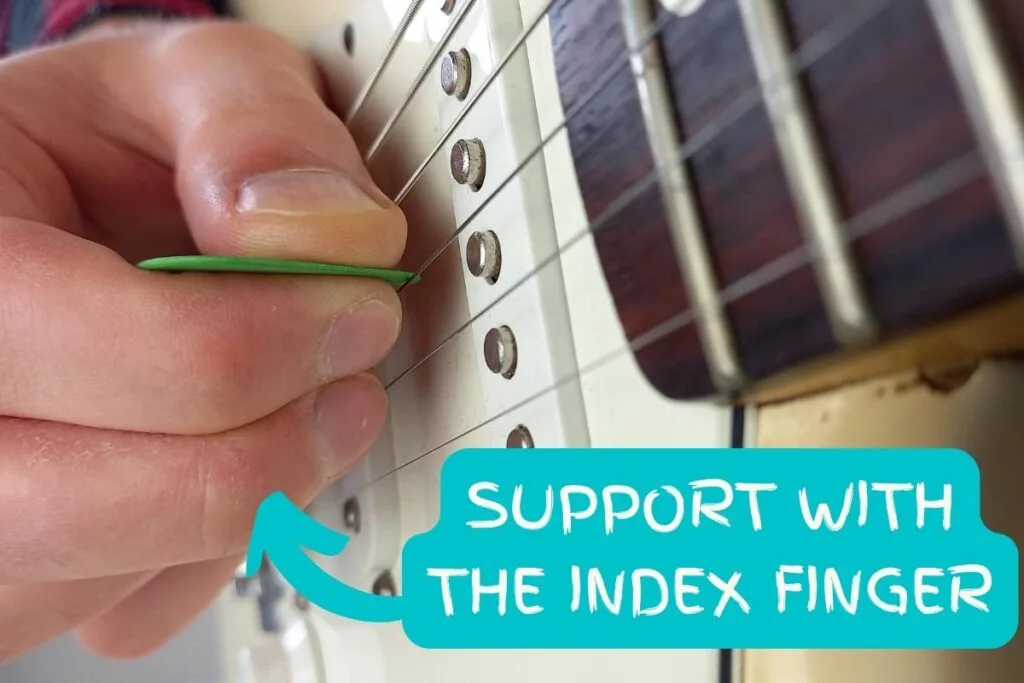
Advanced guitar picking techniques
Once you’re comfortable with standard picking techniques, you might want to look at more advanced ways of playing. Whether it’s for shredding, hybrid picking, or generally increasing the speed, all guitarists must practice the fundamentals and use their pick appropriately for each style.
Important: Don’t rush to learn these techniques. First, focus on your basic techniques then move onto these. By learning these before perfecting your fundamentals, you risk developing bad habits!
How to hold a guitar pick for speed
When it comes to increasing speed, pick grip is essential. Firstly, alternate picking is the first step to increasing speed as alternating between up and down movements creates a natural flow that is the fastest method to play a single string. Always start with a slower tempo to accurately practice the fundamentals.
This is very important to remember. You might come across people telling you some ways to “quickly improve” your speed, but there aren’t any. The only thing that will improve your picking speed is a lot of practice.
A common recommendation is to adjust your picking angle. Adjusting your picking angle may help with improving your speed, but it will be at the cost of the sound of your strings. Turning your pick inwards at a slight angle reduces the friction of your pick, but it plays the string in a different way. It can end up sounding very nasal. Personally, I don’t recommend trying this – but you can see if it works for you.
My tip is to try a thicker guitar pick. As mentioned, I use the Dunlop Jazz III pick as it’s thicker, smaller, and has a sharp tip. This works great for me, as only a small amount of the pick comes into contact with the string, which reduces resistance and increases speed.
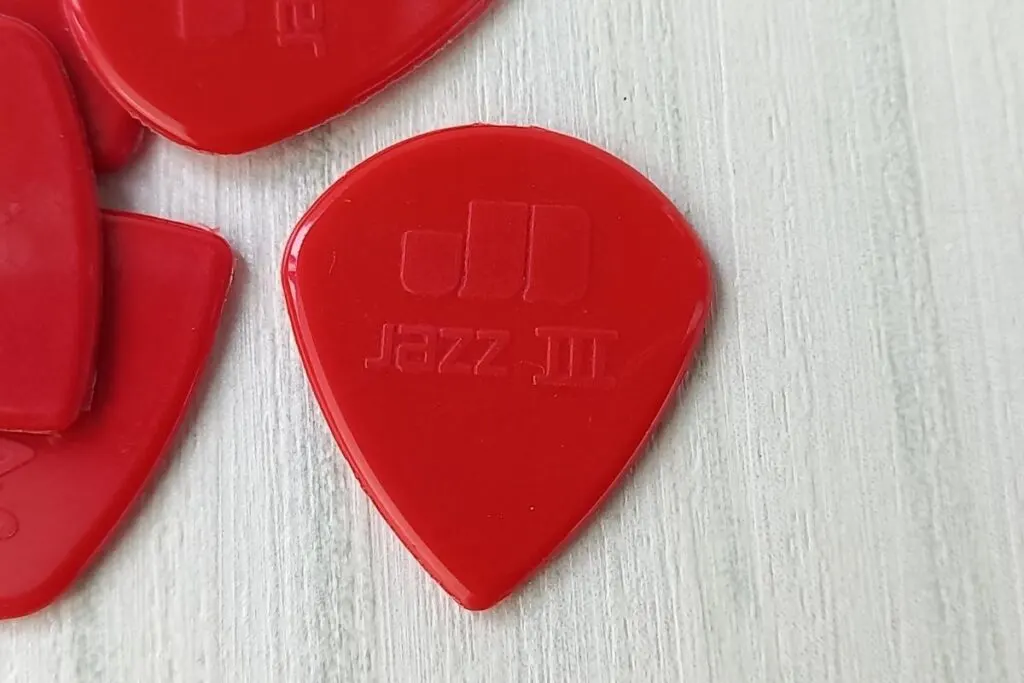
Another tip is to keep your pick close to the guitar strings. The further your pick has to move, the slower your playing will be. So, try keeping your pick into near contact with the strings.
My final tip is to learn about economy picking. This is another picking style that reduces your overall movement, meaning you can pick faster. Check out this economy picking lesson here.
Again, these aren’t magic solutions. They’ll only work when coupled with continuous practice and persistence!
How to hold a guitar pick for shredding
Once you’re comfortable gripping the pick, you’ll be able to focus your attention on wrist movement to improve the shredding ability. Using a pick when shredding famously includes fast alternate picking, string skipping, and sweeping.
Regarding “shredding”, the focus lies more on the wrist action than the gripping of the pick. “Shredding” is essentially playing guitar very quickly, and moving fluidly. The trick is to keep your wrist relaxed, and be able to move it freely up and down the strings. You’ll need to practice relaxed wrist movements to shred comfortably.
String skipping is also common in the shredding styles as it immediately alternates between strings to create distinctive changes in pitch. Once again, the focus lies in a flexible wrist action. You don’t want too much tension, otherwise it will restrict your overall movement.
So, keep your wrist flexible and keep your pick near the string. The key is not to let your arm or wrist rest fully on the guitar, but to rest it lightly so that you can move your arm freely. Here’s a great lesson on string skipping.
Of course, not all techniques follow the same principles, making sweep picking challenging. Sweep picking requires the arm to do most of the action while the wrist stays in a neutral position with the pick at the correct angle. The neutral wrist placement gradually moves the pick up and down the strings without alternating to create a sweeping motion.
Check out these sweep picking exercises to get you started.
How to hold a pick for hybrid picking
Hybrid picking includes using both the pick and the fingers. Common examples include “chicken picking” in country music and thumb picking in folk music. Chicken picking involves using the pick to strike certain notes while the fingers are, either simultaneously or subsequently, playing different notes.
For chicken picking, a standard pick grip (between the thumb and index finger) will leave your other fingers free to pick the other strings. I use this technique a lot when playing blues and country music. My hand tends to form a “claw” shape when I play.
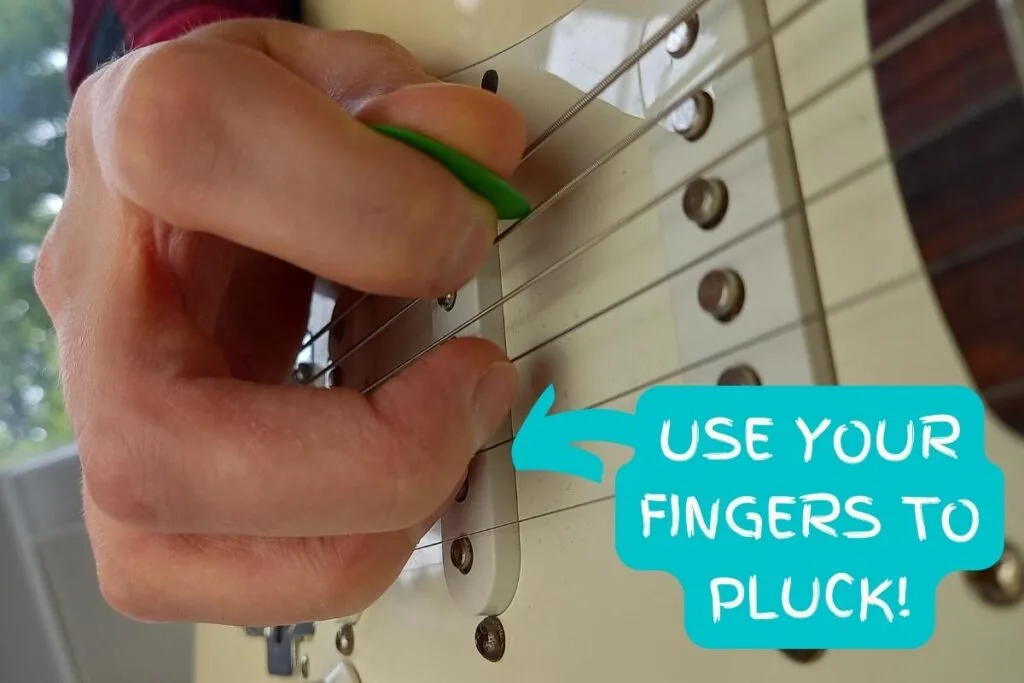
Folk picking is similar, with one big difference.
Folk players tend to use a “thumb pick” instead of a regular pick. The thumb pick is like a ring for your thumb, with a pick on it. The thumb pick is more common among finger-picking style guitarists who want more articulation on the bass notes but still require their index fingers to be free to play the strings.
These types of picks can take some getting used to, but are a great tool to use if you’re looking to play folk music.
Conclusion
The basic methods of using a pick will depend on the style you want to play. Generally, a tighter finger grip with a less visible part of the pick is favored when playing individual notes. That’s the grip that I use. I find that it helps me play faster, and more accurately.
The most important part of learning how to use a guitar pick is practice. Practicing a good technique will make using a guitar pick second nature to you. Eventually, playing with a guitar pick will feel natural, like an extension of your body.
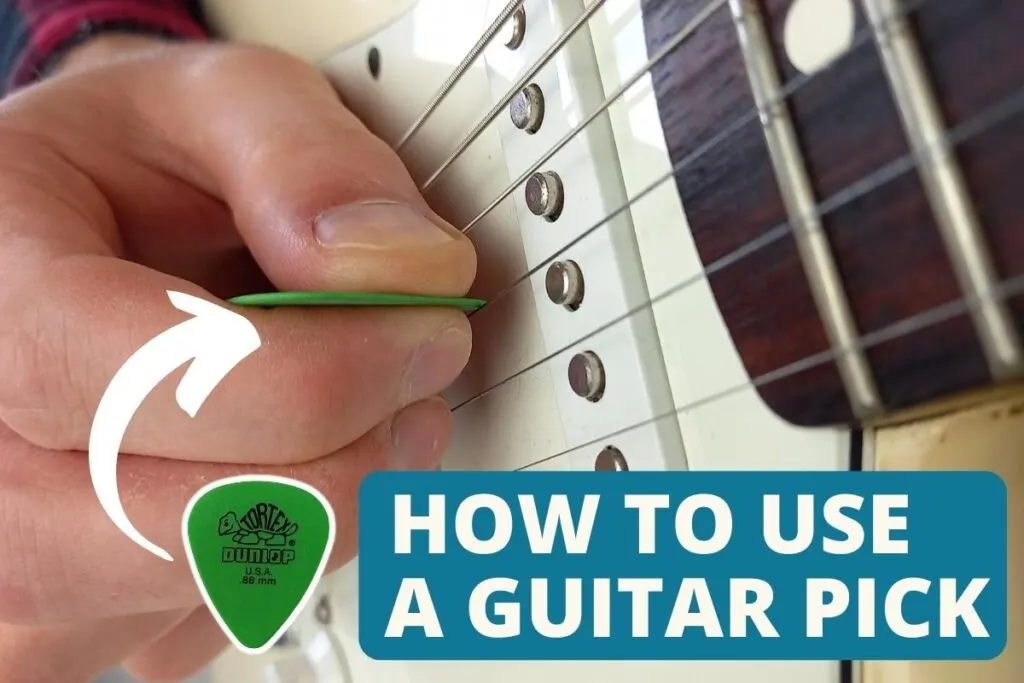

Conor is a music producer, multi-instrumentalist, and all-round enthusiast from the UK with over 15 years of experience. He’s the founder and sole-content creator for the roundtable audio blog and YouTube channel.



